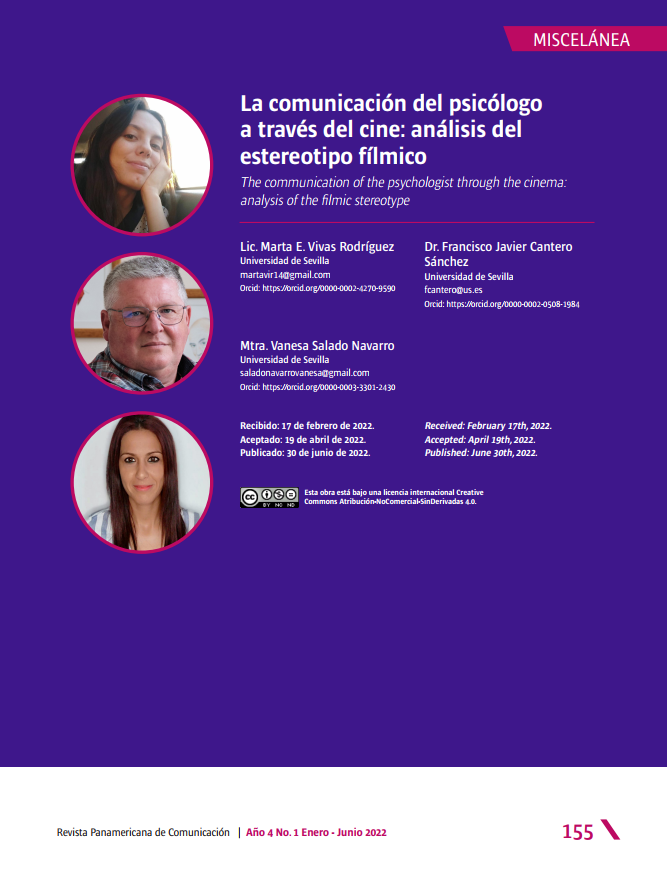La comunicación del psicólogo a través del cine: análisis del estereotipo fílmico
Contenido principal del artículo
Resumen
La presente investigación parte de la premisa de que el cine es una fuente de gran interés para el análisis de la imagen del profesional de la psicología a lo largo del tiempo. El modo en el que el cine ha representado al psicólogo es, en consecuencia, de enorme importancia como generador y transmisor de estereotipos fílmicos. Dos son pues, los objetivos que se han pretendido: analizar la representación que se hace del psicólogo en el cine desde 1930 hasta la actualidad y establecer, con base en lo anterior, los estereotipos básicos del psicólogo en el cine que han intervenido activamente en la construcción de modelos de representación de nuestra disciplina. Para ello se ha seguido una metodología cualitativa de análisis temático, seleccionándose una muestra representativa y describiéndose y analizándose aspectos temáticos como el escenario, la evolución de las escuelas psicológicas representadas, las técnicas escenificadas, las ramas psicológicas presentes, o la imagen social que de todo ello se desprende mediante una categorización del estereotipado fílmico. Como resultados se extraen una evolución creciente a lo largo del tiempo estudiado del número de películas válidas, su relación con determinados géneros cinéfilos (terror, policiaca y forense), la extraordinaria vinculación del estereotipado fílmico con la psicología clínica, la constante ambigüedad con otras disciplinas que constata las dificultades de la autonomía científica de la psicología, o la concordancia de nuestros resultados con los estudios de Sneider y Gabbard con una preferencia del estereotipado tipo “Wonderful”. En definitiva, se considera que el cine, hasta hace pocos años, ha venido confeccionando un estereotipo del profesional de la psicología que ha distorsionado nuestro desempeño profesional. Ello implica un necesario esfuerzo en nuestra profesión por la comunicación científica.
Detalles del artículo
Sección

Esta obra está bajo una licencia internacional Creative Commons Atribución-NoComercial-SinDerivadas 4.0.
Cómo citar
Referencias
» Allport, G. (1979). The Nature of Prejudice. Cambridge, Addison – Wesley.
» Braum y Clarke (2013). Successful qualitative research: a practical guide for beginners. Consultado el 14 de febrero de 2022. En línea: http://dx.doi.org/10.5205/1981-8963.2019.239161
» Brigham, J. (1971). Ethnic stereotypes. Psychological Bulletin, 76 (1), pp. 15-38. Consultado el 14 de febrero de 2022. En línea: https://doi.org/10.1037/h0031446
» Campbell, D. T. (1967). Stereotypes and the perception of group differences. American Psychologist, 22 (10), pp. 817–829. Consultado el 14 de febrero de 2022. En línea: https://doi.org/10.1037/h0025079
» Cano Gestoso, J.I. (1991). Los estereotipos sociales: el proceso de perpetuación a través de la memoria selectiva [Tesis doctoral] Universidad Complutense de Madrid.
» Gabbard, G; Gabbard, K. (1999). Psychiatry and the Cinema. Washington D.C., American Psychiatric Press.
» Mayne, J. (1993). Cinema and Spectatorship. Londres, Routledge.
» Morales Romo, B. (2015). Roles y estereotipos de género en el cine romántico de la última década. Perspectivas educativas. [Tesis doctoral]. Universidad de Salamanca.
» Schneider, I. (1977). Images of the mind. Psychiatry in the commercial film. American Journal of Psychiatry. 134 (6), pp. 613-620. Consultado el 14 de febrero de 2022. En línea: https://doi.org/10.1176/ajp.134.6.613
» Schneider, I. (1987). The theory and practice of movie psychiatry. American Journal of Psychiatry. 144 (8), pp. 996-1002. Consultado el 14 de febrero de 2022. En línea: http://dx.doi.org/10.1176/ajp.144.8.996
» Schultz, H. T. (2005). Hollywood’s Portrayal of Psychologists and Psychiatrists: Gender and Professional Training Differences. En E. Cole & J. H. Daniel (Eds.), Psychology of women book series. Featuring females: Feminist analyses of media (pp. 101–112). American Psychological Association. Consultado el 14 de febrero de 2022. En línea:https://doi.org/10.1037/11213-007
» Tajfel, H. Sheikh, A. A. y Gardner, R.C. (1964). Content of stereotypes and the inference of similarity between members of the stereotyped groups. Acta Psychologica. 22, pp. 191-201. Consultado el 14 de febrero de 2022. En línea: https://doi.org/10.1207/s15327957pspr0902_2
» Wedding, D., y Niemiec, R. (2003). The clinical use of films in psychotherapy. Journal Of Clinical Psychology, 59 (2), pp. 207-215. Consultado el 14 de febrero de 2022. En línea: https://doi.org/10.1002/jclp.10142
» Wedding, D.; Boyd, M.A.; Niemiec, R. (2005). Movies and mental illness: using films to understand psychopathology. Cambridge, Hogrefe.

